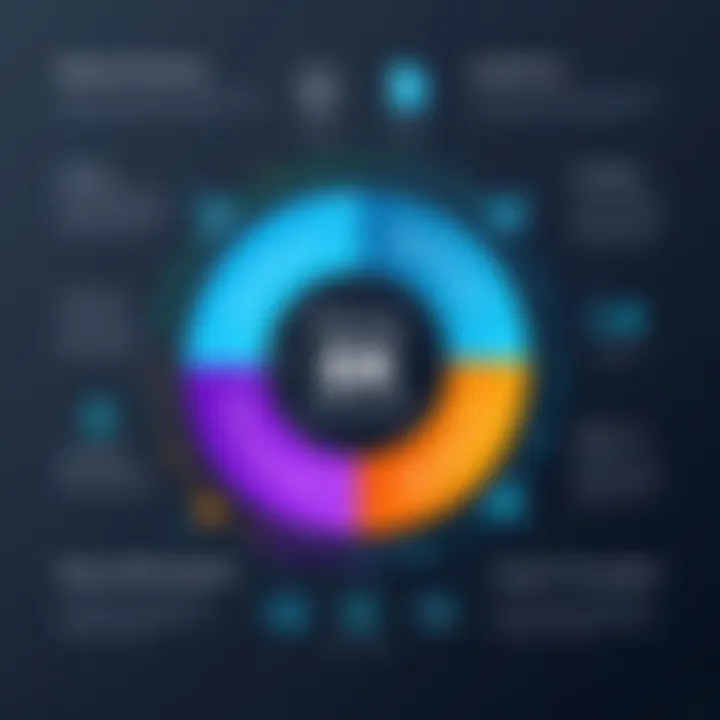Care Efficient Software: Boosting B2B Performance


Intro
In the fast-paced world of B2B solutions, care efficient software is becoming increasingly essential. It is designed to enhance productivity and streamline operations. This software goes beyond simple task management. It integrates various business processes and fosters collaboration. Its importance cannot be underestimated in today's competitive landscape.
Effective software solutions can significantly influence organizational efficiency. They help in cutting down redundant tasks and minimizing errors. Business decision-makers must understand what makes this software qualified as care efficient and how it can be effectively employed to achieve optimal results. This article will guide you through the features, advantages, and the potential drawbacks of care efficient software.
Features Overview
Key Functionalities
Care efficient software encompasses several key functionalities that make it vital for businesses. The primary functions include:
- Task Automation: Automates repetitive tasks, freeing up human resources for more complex activities.
- Data Management: Centralizes data storage, enabling easier access and management of information.
- Real-time Analytics: Provides insights into performance metrics, enabling data-driven decision-making.
- User-Friendly Interfaces: Ensures ease of use for all employees, which can lead to quicker adoption and utilization.
These functionalities are critical. They directly impact a business's operational efficiency and ultimately its profitability.
Integration Capabilities
Another essential aspect of care efficient software is its integration capabilities. The right software must be compatible with existing systems. This helps to ensure seamless data flow and communication. Some notable integration features include:
- API Access: Allows external applications to interact with the software, enabling customized solutions based on specific needs.
- Third-party Software Connectors: Facilitates integration with popular business tools like Salesforce, Slack, or Google Workspace.
- Cloud Compatibility: Provides flexibility in deploying the software, making remote access more convenient for employees.
Having robust integration capabilities minimizes disruptions during implementation. This also ensures continuity in business operations.
Pros and Cons
Advantages
The advantages of utilizing care efficient software are multifaceted. Some of the most prominent benefits include:
- Increased Efficiency: Streamlined processes reduce time spent on mundane tasks.
- Cost Savings: By automating operations, businesses can save on labor costs and operational inefficiencies.
- Improved Collaboration: Centralized platforms foster teamwork by allowing easy sharing of information across departments.
Such benefits not only improve everyday functions but also contribute to long-term organizational success.
Disadvantages
Despite its various advantages, there are challenges associated with implementing care efficient software. These drawbacks may include:
- Integration Challenges: Some businesses may face difficulties when integrating new software with existing platforms.
- User Resistance: Employees may be hesitant to adopt new software, leading to underutilization.
- Upfront Costs: Initial investment in software and training can be high, particularly for small businesses.
Recognizing these potential downsides is crucial for a comprehensive understanding of care efficient software and its impact on business operations.
"Investing in care efficient software is not merely a technological upgrade but a strategic move for the future of business."
Ultimately, decision-makers must weigh both the pros and cons carefully before proceeding with their software choices.
Prologue to Care Efficient Software
The significance of care efficient software cannot be overstated in today’s dynamic business environment. This section serves as a foundation for understanding how such software can transform business operations. By optimizing tasks, these tools enable companies to focus on strategic decisions, rather than getting caught up in mundane processes. Organizations seeking an edge must explore this topic thoroughly.
Defining Care Efficient Software
Care efficient software refers to applications designed with the primary goal of streamlining operations and enhancing productivity. These solutions often integrate various functions into a single platform, helping businesses manage resources more effectively. For example, customer management, task allocation, and data analysis can all be handled in a unified manner.
Key characteristics of this software include:
- User-Friendliness: The interfaces allow users to execute tasks with minimal training.
- Integration Capabilities: It can interact smoothly with existing systems, enhancing overall functionality.
- Flexibility: The software adapts to business scale and changing needs.
Importance in Modern Business Context
In the current landscape, where digital transformation is pivotal, care efficient software holds substantial importance. Businesses are inundated with data and operational complexities. Efficient software tools help mitigate these challenges, ensuring that companies can pivot quickly in response to market trends.
The impact is profound. Companies utilizing care efficient software often report tangible improvements in:


- Operational Efficiency: Streamlined processes lead to faster completion of tasks.
- Cost Management: By reducing redundant operations, businesses can lower overhead costs.
- Employee Satisfaction: Improved workflows result in a better work environment.
Core Features of Care Efficient Software
In the evolving landscape of business technology, understanding the core features of care efficient software is crucial. These features significantly influence how businesses can optimize their operations and improve overall productivity. By diving into these elements, one gains insight into how such software facilitates seamless connectivity, enhances user experience, and supports growth.
User-Friendly Interfaces
A standout feature of care efficient software is its user-friendly interface. This design aspect is vital because it minimizes the learning curve for employees. When software is intuitive, users can quickly adopt it, which translates to less downtime and increased productivity. Moreover, a clean and organized interface reduces cognitive load, allowing users to focus on their tasks rather than deciphering complicated commands. For example, software like Microsoft Teams offers a simple navigation experience, which helps users communicate effectively without frustration. Emphasizing usability ensures that all team members, regardless of tech-savviness, can engage and contribute meaningfully.
Integration Capabilities
Another essential feature to consider is integration capabilities. In a business setting, software solutions rarely exist in isolation. Care efficient software must interface smoothly with existing tools and systems. This integration not only streamlines workflows but also promotes data consistency and accuracy across platforms. For instance, Salesforce provides various application programming interfaces (APIs) that allow businesses to connect other applications seamlessly. When companies can consolidate information from multiple sources, they can make faster, data-driven decisions, thus enhancing operational efficiency.
Scalability and Flexibility
Scalability and flexibility represent core attributes that ensure software remains relevant as businesses grow and evolve. As organizations expand, their software needs can change dramatically. Care efficient software must therefore adapt to increasing data loads and user demands without compromising performance. Companies like Zoho provide scalable solutions that cater to small startups and large enterprises alike, making it easier for businesses to scale operations without the need for constant software replacements. This adaptability not only saves time but also minimizes financial strain caused by frequent software upgrades, promoting a more sustainable technology investment.
"Choosing the right care efficient software with strong features can define a company's operational success."
In summary, the core features of care efficient software—user-friendly interfaces, robust integration capabilities, and scalability—are vital in creating an effective business environment. These elements allow organizations to optimize processes, improve teamwork, and adapt to changing demands effortlessly.
Benefits of Implementing Care Efficient Software
In today's competitive landscape, care efficient software stands out as a crucial asset for any B2B organization. Implementing this type of software yields significant benefits that can directly impact an organization’s operational success. These benefits include enhancing operational efficiency, employing cost reduction techniques, and improving data management capabilities. Each of these aspects contributes to a more streamlined workflow, enabling businesses to focus on their core objectives while minimizing resource wastage.
Enhanced Operational Efficiency
One of the primary advantages of care efficient software is the enhancement of operational efficiency. Streamlined processes and automated tasks allow teams to accomplish more in less time. For instance, implementing tools like Salesforce can enable sales teams to manage customer relationships more efficiently. The software provides features that automate follow-ups and track interactions, creating a more organized framework.
A key factor in this efficiency is the ability to centralize data. Care efficient software often consolidates various functionalities, allowing users to access necessary information from a single platform. As a result, the time lost in switching between applications is drastically reduced. This not only saves time but also fosters collaboration among team members. Effective communication tools integrated within the software further support this goal.
Cost Reduction Techniques
Cost effectiveness is another substantial benefit of implementing care efficient software. By automating daily operations, organizations can cut down on labor costs. For example, solutions like Zoho CRM offer automation for crucial processes such as marketing campaigns and customer service inquiries. Reducing the number of manual tasks can lead to significant savings in operational expenses.
Moreover, care efficient software often eliminates the need for multiple subscriptions to different tools. Instead, organizations can utilize one comprehensive solution that meets various needs. This consolidation reduces overhead and leads to better budgeting. However, it's essential to understand not just the immediate savings but to articulate how these systems can contribute to long-term financial benefits, as they facilitate improved decision-making and strategy formulation.
Improved Data Management
Data management is vital for any B2B operation; efficient software enhances this aspect remarkably. A robust data management system allows for real-time data updates and reporting, leading to more accurate decision-making. Tools like Microsoft Dynamics 365 help businesses organize vast amounts of data while offering powerful analytics. Users can generate insights from customer interactions, thus making informed marketing and sales strategies.
Effective data management also plays a significant role in compliance and risk management. Many care efficient software solutions ensure that data handling processes comply with industry regulations, such as GDPR. Consequently, organizations can mitigate risks associated with data breaches and ensure they are adhering to necessary guidelines.
"In an era defined by information, the ability to harness data effectively is no longer optional; it is essential for survival."
Challenges in Care Efficient Software Adoption
Adopting care efficient software is not just a technical transition for businesses, but a complex process filled with potential hurdles. Identifying and understanding these challenges is crucial. Failure to address them can lead to significant roadblocks that hinder the effectiveness of the software implementation. This section discusses key challenges that organizations encounter during the adoption process, focusing on three specific areas: Resistance to Change, Integration with Existing Systems, and Resource Allocation and Training. Each of these factors impacts how well the software can perform and deliver its intended benefits.
Resistance to Change
Resistance to change is a common phenomenon in organizational settings. Employees may feel threatened by new software, fearing it could affect job security or alter their established workflows. This sense of apprehension can lead to a lack of engagement with the new system. To combat this, management must communicate the benefits effectively.
- Understanding the Benefits: It’s vital that employees recognize how the software can enhance their daily tasks.
- Involvement in Decision Making: Engaging employees early in the decision process can create a sense of ownership regarding the new system.
- Feedback Systems: Establish mechanisms for employees to express concerns and provide feedback about the software and its rollout.
Overcoming resistance requires patience and consistent effort from leadership to cultivate a culture that embraces change.
Integration with Existing Systems
Integrating care efficient software into an existing technological landscape can present another significant challenge. Many companies rely on legacy systems, which may not be fully compatible with new applications.
- Assess Compatibility: Conducting a thorough assessment before implementation can clarify what modifications or updates are needed.
- Phased Rollout: Implementing the software in phases can allow for smoother transitions. This way, issues can be identified and resolved gradually, minimizing disruption to operations.
- Partnership with Vendors: Work closely with software vendors who provide support during integration. Their expertise can streamline the process and ensure compatibility.


Addressing integration challenges early is paramount, as failing to do so can result in increased costs and lost productivity.
Resource Allocation and Training
Allocating sufficient resources for both the implementation of care efficient software and the training of staff is crucial for its success. Many organizations underestimate the importance of training, thinking that the software will be intuitive enough for employees to adopt with little guidance. This can lead to a poor user experience and counterproductive outcomes.
- Budgeting for Resources: Allocate a realistic budget that accounts for softwaer costs, training programs, and any necessary changes to infrastructure.
- Comprehensive Training Programs: Providing thorough training tailored to different user levels ensures that all employees can use the software effectively. Training should not be a one-time event but an ongoing process.
Training and proper resource allocation should be treated as essential investments, not simple operational costs. Failing to invest in these areas can jeopardize the return on investment from the software.
Understanding these challenges is critical for stakeholders. By anticipating these issues, organizations can formulate effective strategies to overcome them, ensuring a successful adoption of care efficient software.
Navigating through these challenges requires careful planning and a well-thought-out strategy. Addressing human factors, technical compatibilities, and resource needs methodically will lead to more successful implementations.
Evaluating Care Efficient Software Solutions
Evaluating care efficient software solutions is crucial for organizations looking to optimize their operations. This evaluation process enables decision-makers to discern which software best meets their needs and aligns with their business goals. Effective evaluation goes beyond basic functionalities; it demands a close inspection of key elements that influence productivity and cost-effectiveness.
Software evaluation directly impacts efficiency and resource allocation. Organizations benefit from assessing how well a solution integrates with their existing systems and processes. Moreover, evaluating software helps mitigate risks associated with poor implementation. An informed decision reduces the chances of financial waste and operational disruption. To successfully evaluate care efficient software, several factors need to be taken into account.
Key Considerations for Selection
Selecting the right care efficient software involves critical considerations. First, the specific needs of the organization must be assessed. Stakeholders should analyze what challenges the software needs to address and how it can enhance current workflows. Customization features are also essential. A solution that can be tailored to suit unique business requirements often leads to higher adoption rates and better employee satisfaction.
Next, usability cannot be overlooked. A user-friendly interface is important for ensuring that employees can adapt to the new system with minimal resistance. Additionally, it is vital to consider the integration capabilities of the software. It should work seamlessly with existing tools and platforms to facilitate data flow and minimize disruptions.
Finally, organizations should contemplate the long-term scalability of the software. As a business grows, its software should be able to manage increased demands without compromising performance. Choosing software with strong scalability features can avert the costs of future replacements.
Reviewing Vendor Reputation
When assessing care efficient software solutions, understanding the reputation of vendors is paramount. A vendor's history can provide insights into the reliability and performance of their offerings. Organizations should conduct thorough research on vendors, investigating their track record of customer satisfaction and product support.
Online reviews and testimonials from existing users can serve as valuable resources. These insights often reveal the strengths and weaknesses of the software in real-world scenarios. Engaging in forums like Reddit may offer additional perspectives from industry peers.
It's also beneficial to check for industry certifications and compliance with relevant standards. A reputable vendor will likely adhere to best practices and regulations, ensuring security and data integrity. Furthermore, consider the vendor's engagement with ongoing support and updates. A proactive vendor often indicates a commitment to enhancing their software and addressing customer needs in the long run.
Understanding Pricing Models
Understanding pricing models is essential for making informed choices about care efficient software. Various vendors deploy different pricing structures, and recognizing these can unravel potential long-term costs. Common models include subscription fees, perpetual licensing, and pay-as-you-go options. Each has its benefits and disadvantages.
- Subscription Fees: These typically involve recurring payments, which can be more manageable for budgeting. However, costs can accumulate over time if the software is used long-term.
- Perpetual Licensing: This one-time fee provides ownership of the software, possibly offering savings in the long run. Yet, it may demand a larger upfront investment.
- Pay-as-You-Go: This flexible model allows businesses to pay for just what they use. While it appears cost-effective, it can be unpredictable depending on usage patterns.
Lastly, inquire about hidden fees for additional services or upgrades. Blanket pricing may not account for every business's specific needs, so it is essential to clarify terms.
Top Care Efficient Software Solutions
The selection of care efficient software solutions plays a pivotal role in how businesses optimize operational performance. Choosing the right software can enhance productivity, improve customer satisfaction, and streamline workflows. Having the right tools ensures that companies can meet demands effectively while efficiently managing resources.
This section aims to provide insights into leading products and their unique attributes, giving decision-makers a comprehensive overview that informs their choices. As organizations navigate through myriad options available today, focusing on specific elements such as functionality, integration capabilities, and user experiences becomes essential.
Furthermore, understanding the benefits of each solution can offer a clearer perspective when evaluating which software aligns best with organizational goals.
Overview of Leading Products
In this competitive marketplace, several software solutions stand out for their ability to enhance care efficiency. These products are designed with user needs in mind, providing valuable features tailored for business environments. Some of the notable offerings include:
- Salesforce: Known for its robust CRM capabilities, Salesforce integrates various functions for comprehensive customer management.
- HubSpot: A popular choice among marketers, HubSpot offers tools for content management, social media, and email marketing.
- Zendesk: Focused on customer support, Zendesk provides features that facilitate efficient ticketing and user engagement.
- Microsoft Dynamics 365: This solution combines CRM and ERP, offering a full suite of apps to enhance operational processes across departments.
- Slack: More than a messaging platform, Slack enables collaboration with integrated apps that enhance team communication and project management.
These software solutions not only help in solving current business challenges but also prepare organizations for future demands.
Comparative Analysis of Features
When choosing software solutions, it is crucial to perform a comparative analysis of their features. Different products cater to varying business needs, so understanding these attributes can be beneficial. Essential features to consider include:
- Integration Capabilities: The ability of software to integrate with existing systems is critical. For instance, Salesforce allows seamless integration with other platforms, enabling a unified approach.
- User Experience: A user-friendly interface can significantly reduce training time and improve employee adoption rates. HubSpot excels here, with its intuitive design.
- Customization Options: Some solutions, such as Microsoft Dynamics 365, enable extensive customization, allowing businesses to tailor functionalities to their specific requirements.
- Analytics and Reporting: Many leading products offer advanced analytics tools that assist in decision-making by providing insights into performance metrics. Zendesk, for example, provides real-time data on customer interactions and support ticket trends.
- Scalability: It is important for businesses to choose solutions that can grow with them. Both Salesforce and Microsoft Dynamics 365 scale efficiently, accommodating the needs of larger organizations.


Understanding these features and how they align with business objectives is essential to selecting the most suitable care efficient software.
In summary, exploring top care efficient software solutions is not just about identifying products but about finding the right fit for unique business needs. This thoughtful approach ensures organizations can optimize their operations effectively, making informed decisions that will support both immediate and long-term goals.
User Experiences and Testimonials
User experiences and testimonials serve a crucial role in understanding the impact of care efficient software on real-world applications. When organizations consider adopting such software solutions, they seek validation through the voices of current users. These insights provide an authentic perspective on how software performs in various operational settings. This exploration aids potential users in assessing practical benefits and drawbacks before making an investment.
Case Studies of Successful Implementations
Successful implementations of care efficient software offer concrete evidence of its effectiveness. These case studies chronicle how different businesses integrate such solutions into their workflows and the resulting outcomes. For instance, a healthcare provider that adopted a particular software solution saw a notable increase in patient management efficiency. Previously, their appointment scheduling was fragmented across various platforms, leading to errors and confusion.
Upon implementing the new care efficient software, they achieved a seamless, centralized system. As a result, appointment errors were reduced by over 35%, demonstrating significant operational improvement. Another case featured a financial services company that utilized advanced data analytics capabilities within their software. The management of client portfolios improved significantly, enabling more accurate risk assessment and faster decision-making processes.
These examples highlight not just the benefits but also how challenges can be overcome through tailored software solutions. They emphasize the importance of thorough planning and adjustment during the transition period.
Common Pain Points Experienced
While testimonials typically showcase success, it is equally important to acknowledge the common pain points experienced by users of care efficient software. Transitioning to new software often comes with unexpected hurdles. Users frequently report issues with data migration during the initial stages, which can complicate operations. A notable pain point involves the resistance from teams accustomed to legacy systems. Employees may struggle to embrace new workflows, leading to a temporary dip in productivity.
Moreover, some users mention difficulties with learning curves related to complex interface designs. Although modern care efficient software strives for user-friendly experiences, variability exists in software intuitiveness. In cases where training is inadequate, employees might feel overwhelmed. This emphasizes the need for tailored training programs that cater to different learning speeds.
"Adopting care efficient software can unlock potential, but organizations must prepare for the accompanying challenges."
Ultimately, addressing these common pain points is essential. Acknowledging that user experiences encompass both triumphs and troubles provides a fuller picture of the software's net value. It encourages businesses to mentor their teams through transitions and invest in systematic training efforts.
Future Trends in Care Efficient Software
The evolution of software technology is a constant process, particularly in the realm of care efficient software. As businesses strive for increased efficiency, understanding future trends becomes essential. These trends not only shape the software landscape but also influence how companies approach operations, data management, and decision-making. Adapting to these changes can drive competitive advantage, making it important for organizations to stay informed about what lies ahead.
Emerging Technologies Impacting Software Efficiency
The integration of emerging technologies represents a significant turning point for care efficient software. Businesses now face an array of technologies that promise to enhance operational functionality. Here are some key areas to consider:
- Cloud Computing: This technology facilitates access to software and data from any location, enhancing collaboration and flexibility for businesses.
- Blockchain: Introducing an additional layer of security and transparency, blockchain can improve trust among stakeholders while streamlining operational processes.
- Internet of Things (IoT): IoT devices generate vast amounts of data. Efficient software solutions can utilize this data for better resource management and predictive analytics.
Embracing these technologies helps businesses to optimize their operations. They provide tools that allow for better resource allocation and improved customer experiences, leading to overall increased satisfaction.
The Role of Artificial Intelligence
Artificial intelligence (AI) is increasingly integral to care efficient software. By automating routine tasks, AI helps reduce human error and improves efficiency. Consider these aspects of AI implementation:
- Data Analysis: AI algorithms can analyze large data sets much faster than human researchers. This provides insights that go beyond traditional analysis, aiding strategic decision-making.
- Personalization: By leveraging AI, companies can personalize interactions with clients, increasing engagement and satisfaction levels.
- Predictive Maintenance: AI can anticipate potential system issues before they arise. This proactive approach minimizes downtime and enhances the overall reliability of software solutions.
"AI is not just a tool; it is a revolutionary change in how organizations operate and interact with their data."
In essence, integrating AI within care efficient software not only augments performance but also drives businesses toward future growth. As organizations adjust to these innovations, their capacity for effective management and strategic planning improves.
The journey to adopt these trends is crucial. Businesses that intelligently leverage emerging technologies and AI will likely see enhanced operational efficiency and a marked improvement in their competitive positioning.
Epilogue and Recommendations
In the dynamic landscape of business technology, care efficient software stands out as a vital component for organizations aiming to optimize their operations. This article thoroughly explores this crucial subject, illustrating how thoughtful implementation and effective utilization of care efficient software can lead to significant operational improvements. Recommendations made in this section are meant to guide decision-makers toward successfully integrating such solutions into their businesses.
Importance of The End and Recommendations
The significance of providing a conclusion and recommendations in any article lies in summarizing the main insights while encouraging actionable steps based on the information presented. The concluding section serves several purposes: it distills the critical elements discussed throughout the article,
- Reinforces the importance of investing in care efficient software for enhanced performance.
- Offers practical advice to aid readers in evaluating their options effectively.
- Encourages a forward-thinking approach that capitalizes on evolving technologies and best practices.
The recommendations formulated in this section should not be overlooked. They enable B2B professionals to make informed choices regarding their software investments, ensuring alignment with their organizational goals and operational requirements. The insights gathered through user experiences, market analysis, and future trends equip business leaders with the knowledge necessary to navigate the complexities of software deployment.
Summarizing Key Takeaways
To grasp the full value of care efficient software, consider the following key takeaways:
- Operational Efficiency: Care efficient software streamlines processes, ensuring higher productivity and faster decision-making.
- Cost-Effectiveness: Implementing such software can lead to significant cost savings by optimizing resource allocation and minimizing waste.
- Integration with Existing Systems: A successful adoption relies on software that meshes well with current tools, allowing for a seamless transition.
- User-Centric Design: Software that is user-friendly enhances employee engagement, ultimately leading to better utilization of the systems implemented.
- Future-Proof Solutions: Companies should seek software solutions that keep pace with emerging technologies like artificial intelligence, which can provide added value and insights into operations.
"In today’s competitive landscape, the adoption of care efficient software is no longer optional, but a necessity for thriving organizations."







